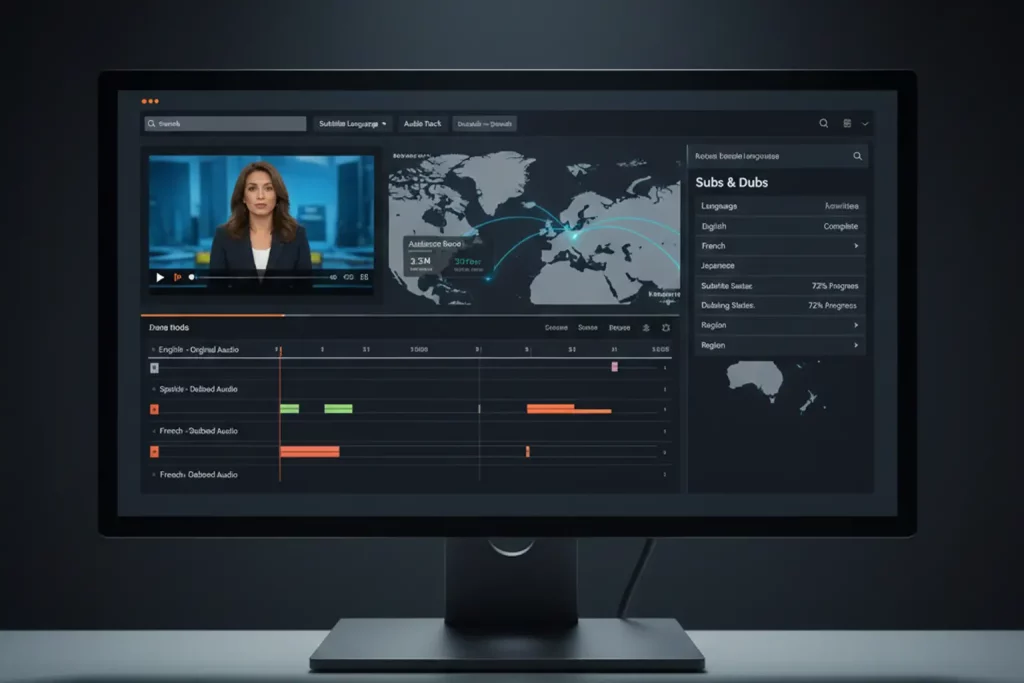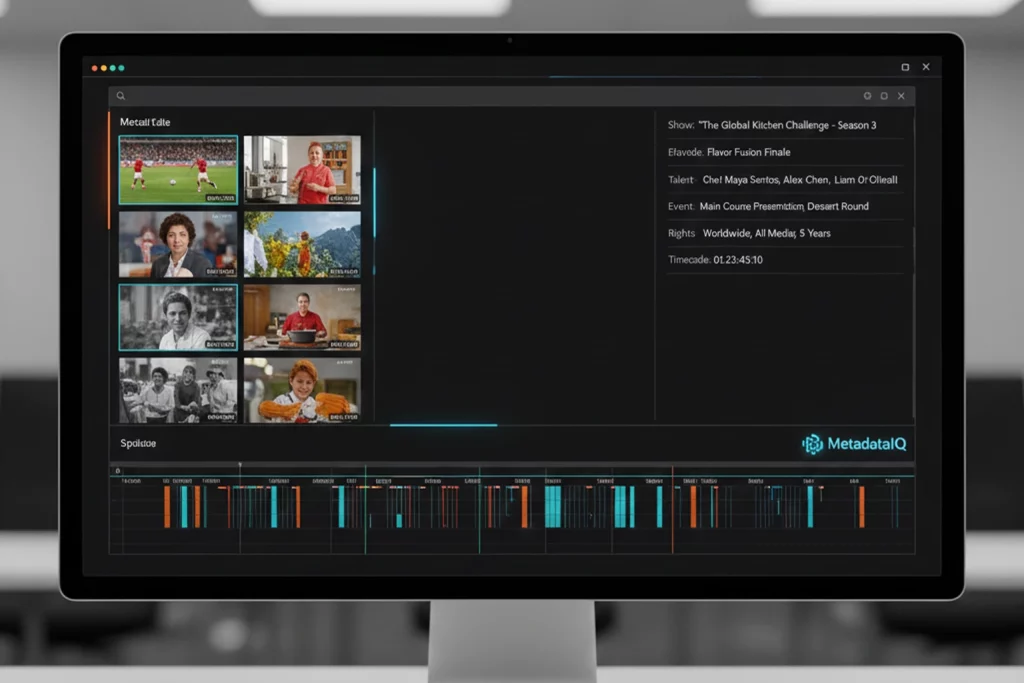In an era where video content is everywhere, making this content easily discoverable and manageable remains a significant challenge. This is where video metadata plays a crucial role. The information embedded within or associated with a video file can greatly enhance its accessibility and usability for search engines and end-users. This article delves into the pivotal role of video metadata, exploring its types, benefits, best practices, and the challenges involved in its management.
Overview of Video Metadata
Video Metadata refers to the textual or structured information that describes and provides context to video content. This includes elements like the video’s title, description, tags, and more complex data such as chapters, segments, and rights information. The primary aim of video metadata is to improve content discoverability, making it easier for search engines and users to find, categorize, and understand the video.
Leveraging MetadataIQ for Effective Video Metadata Creation
Automating Metadata Creation
MetadataIQ offers advanced tools for automating the creation of accurate metadata. By leveraging algorithms and machine learning, MetadataIQ can generate relevant metadata quickly and efficiently, reducing the manual workload and ensuring consistency.
Improving Content Discoverability
MetadataIQ enhances content discoverability by optimizing video metadata for search engines and users. This leads to better search rankings and higher user engagement, making it easier for users to find and interact with video content.
Streamlining Content Management
MetadataIQ simplifies the organization and management of video assets. A centralized metadata management platform ensures that all video content is indexed, categorized, and easily retrievable, making content management more efficient.
Ready to experience the future of metadata creation and content management? Schedule a free demo today!
The Role of Metadata in Video Content
Enhancing Content Discoverability
Metadata plays a critical role in improving the searchability and discoverability of video content. By embedding relevant keywords and phrases, you can ensure your video appears in search queries. This drives more traffic and enhances the overall user experience by enabling users to find the content they are looking for quickly and efficiently.
Impact on User Experience and Content Engagement
Quality metadata directly impacts user engagement. When users can easily find what they are looking for, they are more likely to engage with the content, leading to higher retention rates and better user satisfaction.
Types of Video Metadata
Descriptive Metadata
Descriptive metadata includes a video’s title, description, and tags. This type of metadata is crucial for video SEO as it helps search engines understand what the video is about. For example, a video titled “How to Bake a Cake” with tags such as “baking,” “cake,” and “recipe” will be more discoverable for users searching for baking-related content.
Structural Metadata
Structural metadata organizes the video content into chapters, segments, or scenes. This is particularly useful for long-form content, enabling users to navigate directly to the part of the video that interests them. For example, an educational video might have chapters for different topics, making it easier for students to find the specific information they need.
Administrative Metadata
Administrative metadata includes information essential for content management but not necessarily visible to the end-user. This can include rights and licensing information, technical specifications, and author details. Such metadata is crucial for managing video libraries, ensuring all content is stored, accessed, and used in compliance with legal and organizational guidelines.
Benefits of Implementing Video Metadata
- Improved Content Discoverability: Users can find relevant video content more easily.
- Efficient Content Management: Streamlined organization and retrieval of video assets.
- Enhanced Search Engine Optimization (SEO): Metadata helps search engines index and rank video content effectively.
Improved Search Engine Optimization (SEO)
Video metadata significantly boosts SEO rankings by incorporating relevant keywords and structured data. Search engines like Google use this metadata to index video content, making it easier for users to find relevant videos through search queries. When metadata is well-crafted with accurate keywords, titles, and descriptions, search engines can better understand the content of the video and match it with users’ search intent. This leads to higher visibility in search results, driving more organic traffic to the video. Additionally, structured data, such as schema markup, provides search engines with precise information about the video’s content, enhancing the chances of appearing in rich snippets and video carousels, which are highly engaging and clickable.
Enhanced User Experience
Accurate and detailed metadata helps users quickly find the content they are looking for, enhancing their overall experience. For instance, a well-tagged video will appear in relevant searches, making it more likely to be watched and shared. When users can easily locate videos that match their interests or needs, they are likelier to engage with the content, watch it fully, and share it with others. Metadata that includes chapter markers or segments allows viewers to navigate directly to the sections of the video that interest them the most, reducing frustration and improving satisfaction. This accessibility and ease of use fosters a more engaging and enjoyable viewing experience, increasing the likelihood of repeat visits and higher retention rates.
Efficient Content Management
Metadata simplifies the organization and retrieval of video assets. With proper metadata, media asset management systems can categorize and index video files efficiently, making it easier to manage extensive video libraries. Detailed metadata provides a robust framework for organizing content based on criteria such as topic, genre, date of creation, and more. This structured approach enables quick and efficient searching, sorting, and filtering of video content, saving time and resources for content managers. Additionally, administrative metadata, which includes rights and licensing information, ensures that all content is used in compliance with legal and organizational guidelines, reducing the risk of unauthorized usage and potential legal issues. Efficient metadata management also supports better tracking and analysis of video performance, providing valuable insights that can inform future content strategies and optimization efforts.
Best Practices for Adding Metadata to Video Content
Consistency and Accuracy
Consistent and accurate metadata is essential for effective content management and discoverability. Inconsistent metadata can lead to confusion and make it difficult for users to find relevant content. Regular audits and updates help maintain metadata quality.
Utilizing Standardized Formats
Standardized metadata formats like Dublin Core or Schema.org ensure compatibility and easier integration with various platforms and systems. These formats provide a consistent structure, making managing and sharing metadata easier across different platforms.
Automation Tools for Metadata Generation
Automated metadata tools can significantly reduce the time and effort required to generate metadata. These tools use algorithms to analyze video content and generate relevant metadata, ensuring accuracy and consistency while reducing manual labor.
Overcoming Challenges in Metadata Management
Managing video metadata effectively can be daunting, especially as the volume of video content continues to grow. To tackle these challenges, robust strategies must be implemented to ensure metadata quality and consistency across all video assets.
Handling Large Volumes of Content
One of the primary challenges in metadata management is dealing with extensive video libraries. As video content increases, manually managing metadata becomes impractical and time-consuming. Here are some strategies to streamline this process:
- Batch Processing: This technique involves processing multiple video files simultaneously rather than handling them individually. Organizations can save time and ensure consistency across their video library by applying metadata updates in bulk. Batch processing tools can automate the addition of metadata to large sets of videos, making it easier to manage extensive content libraries.
- Automated Tools: Utilizing automated metadata generation tools can significantly reduce the workload of managing large volumes of content. These tools leverage algorithms and machine learning to analyze video content and generate relevant metadata accurately and efficiently. Automation speeds up the process and minimizes human errors, ensuring that metadata is consistently applied across all video assets.
- Centralized Metadata Management Systems: Implementing a centralized system for managing metadata can help organizations maintain a unified approach. These systems allow for the standardized application and updating of metadata, making it easier to manage large video libraries. Organizations can ensure that all video content adheres to the same standards and practices by centralizing metadata management.
Ensuring Metadata Quality
Maintaining high-quality metadata is crucial for effective content discoverability and user experience. Inaccurate or outdated metadata can lead to poor search engine rankings and frustrate users who rely on accurate information to find relevant content. Here are some best practices to ensure metadata quality:
- Regular Audits: Conducting regular audits of video metadata is essential to identify and rectify any inaccuracies or inconsistencies. Audits should thoroughly review the metadata associated with each video file, checking for errors, outdated information, and missing data. Regular audits help maintain the integrity of metadata, ensuring that it accurately reflects the content of each video.
- Updates and Maintenance: Metadata should be treated as a dynamic element that requires ongoing updates and maintenance. As video content evolves or new information becomes available, metadata should be revised to reflect these changes. Implementing a schedule for regular updates ensures that metadata remains current and relevant.
- Training and Guidelines: Providing comprehensive training and clear guidelines for those involved in metadata management can help maintain quality. Staff should be trained on the importance of metadata, how to apply it accurately, and best practices for updating and auditing metadata. Clear guidelines ensure everyone follows the same standards, reducing the likelihood of errors.
- Quality Control Mechanisms: Implementing quality control mechanisms, such as automated validation tools and peer reviews, can help catch errors before they impact the user experience. Automated validation tools can check for common issues such as missing fields, incorrect formats, and inconsistent data. Peer reviews involve multiple team members reviewing metadata entries to catch any errors automated tools might miss.
- User Feedback: Encouraging feedback from users can provide valuable insights into the effectiveness of your metadata. Users can identify issues that may not be apparent during internal reviews, such as irrelevant tags or misleading descriptions. Incorporating user feedback into your metadata management strategy can help improve the accuracy and relevance of metadata over time.
By implementing these strategies, organizations can overcome the challenges of managing large volumes of video metadata and ensure their metadata remains accurate, consistent, and high-quality. This, in turn, enhances content discoverability, user experience, and overall content management efficiency.
Conclusion
Video metadata is crucial for improving content discoverability, enhancing user experience, and streamlining content management. Organizations can maximize the benefits of video metadata by implementing best practices such as consistent and accurate metadata, utilizing standardized formats, and leveraging automation tools. It’s time to elevate your video content by implementing effective metadata strategies. Explore solutions like MetadataIQ to automate and optimize your metadata management, ensuring your video content is easily discoverable, engaging, and well-organized.
In conclusion, video metadata is not just an accessory but necessary for any organization in video content production and distribution. Understanding its importance and implementing best practices can significantly enhance your content’s visibility, engagement, and management.
Digital Nirvana: Empowering Metadata Management Through Technology
Digital Nirvana leads with advanced metadata management solutions and business process automation in the digital era.
- Metadata Management Solutions: Enhance organizational efficiency and discovery through precise metadata.
- Business Process Automation: Streamline metadata operations with sophisticated automation tools.
- AI-Based Workflows: Optimize metadata creation and data analysis with AI.
- Machine Learning & NLP: Continuously improve metadata workflows with advanced algorithms.
- Global Reliability: Trusted worldwide for scaling metadata operations, ensuring compliance, and reducing costs.
Book a free demo to scale up your metadata strategy for your video assets with minimal effort and experience Digital Nirvana’s services firsthand.
FAQs:
1. What is video metadata?
Video metadata refers to the textual or structured information that describes and provides context to video content. This includes titles, descriptions, tags, chapters, and administrative details like rights information.
2. How does metadata improve video SEO?
Metadata helps search engines index and rank video content effectively by incorporating relevant keywords and structured data. This makes it easier for users to find videos through search queries.
3. What are the types of video metadata?
There are three main types of metadata: descriptive metadata (titles, descriptions, tags), structural metadata (chapters, segments), and administrative metadata (rights, technical specifications).
4. Why is consistency in metadata important?
Consistent metadata ensures effective content management and discoverability. Inconsistent metadata can lead to confusion and make it difficult for users to find relevant content.
5. How can MetadataIQ help in managing video metadata?
MetadataIQ offers tools for automating metadata creation, optimizing video metadata for search engines, and streamlining the organization and management of video assets.




